#foam scraps recycling
Text



Weekend project! Mounted some steer horns I had acquired from an estate sale a while back :-) 💕
#it went easier than i thought!!! i likely may re-do them in the future with some tooled leather elements once i get a handle on that#but this is good enough for me for now! im happy with it :)#used some fabric and leather scraps i had already#and recycled foam and cardboard from moving for the base!!! surprisingly sturdy too#god its nuts how expensive these normally are too jfc#smaller racks than this costing like $150-$200#idk why horns and antlers are just so expensive lately#one deer horn up here is like#$13????#for why!!!!#my stuff
10 notes
·
View notes
Text
Once upon a time I had a toy carousel as a child,but it broke,and I kept the pieces...except the music box. I may not be 100% sure,but I do believe the song was, probably,most likely,Love story. So that's what I used.
So,after feverish crafting and endless winging,I present :
Scarlet Carousel

Yes let me name it that please ;-;
More pics under the cut!
I've been wanting to make this for well over 3 yrs,it feels like a dream come true! Hands on,it took exactly a week, 6-8hrs per day on most days. I made it almost entirely from scratch, except the music box of course (it was a regular one,I made the rotating mechanism) and the horses which are peagasus figured I sculpted over and repainted. I didn't go in with a solid plan,no sketch either,but I did have some plans,which...many of which I ended up changing mid project. There were many places I had to redo, but in the end I'm really proud of it, please have a look!!



I made sure to add stairs for imaginary kids to climb up,a railing of chains so they don't fall off,and a starry sky so when the nonexistent riders look up,they see something nice!





The inner box is made of scrap mdf from cakes, base made of foam board, and upper tent (?) sculpted with lightweight clay (Artista) ,the filigree from resin casts I've made over years,and most other things either craft store trinkets or recycled trash.

I've recorded most of the process,and I'll be making a video! Let's hope it happens soon!
51 notes
·
View notes
Text

I’ve been meaning to get around to making new period dress form for a long time, particularly given my first go around experimenting with an Edwardian pattern and expanding foam turned out decidedly wonky.
I wanted to make a soft form mannequin this time that would be pliable enough to shape with corsetry but also be sturdy enough to work on the stand.
I started off with Atelier Sylphe’s Victorian Mannequin pattern - no alterations. For the body fabric I used a (truly awful) herringbone poly-wool that has been sitting and taking up to much space in my personal stock for too long (I think acquired during wrap from a production). I would never want this fabric to touch my skin, but it is extremely sturdy with no stretch and next to no ease, easy easily takes and holds a shape. I used the wrong side of the fabric which has less of a nap and is lighter and more even in colour. The unpleasantness of the fabric aside, it gives a an appealingly neutral historical feel which works for a Victorian form.
I didn’t think to take many photos whilst making it!
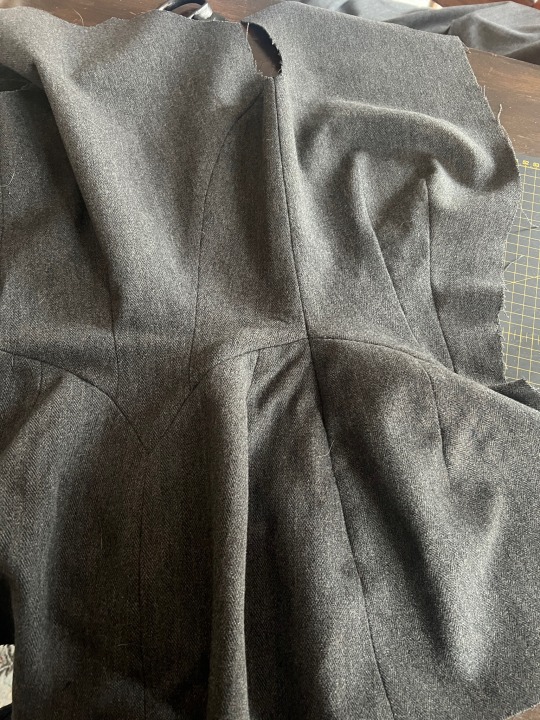

Putting together was straightforward. All seams were left raw internally. For the neckpiece I cut a circle of foamex that glued the seam allowance of the neck fabric two then whipped into the neck of the dress form. I did the same process for the base, whilst also marking out and building up a space for a pole if I want to use this on a stand in the future. For now she will be a table top dress form.
The body was then stuffed with a mix of recycled wadding I had lying around and fabric scraps and off cuts. I also wedged a large sturdy pole I had lying around down the centre to add extra rigidity and stability. The wadding needs a bit of a smoosh around once it’s settled, but she’s turned out nicely!
#poetry in costume#making#project: dress form#project: historical sewing#Victorian dress form#mannequin#costume#sewing#okeydokey let’s start dusting off this blog and start actually posting things#and see what happens
19 notes
·
View notes
Text

Albert the Christmas Star
HAPPY HOLIDAYS EVERYONE! This is Albert.
You can see how he was made here!
Materials we used:
Upcycled shiny fabric that was a gift bag from some random purchase as top fabric (strange but often where I get novelty fabric scraps)
Used shirt with holes on it as lining fabric
Random non-stretch fabric as Albert's guts
Poly fill (best to use the silky smooth kind)
Recycled poly batting from grocery delivery padding material as core wool (or other coarse poly fill would also work)
Carded acrylic yarn in yellow as top wool (hand-carded with a cat hair remover thingy)
Glass sewing pins
Polyester sewing threads
Some paper and pencil for mock-up
Optional: jingle bells from abandoned cat toys
Tools we used:
Sewing needles
Felting needles
Seam ripper
Scissors
Wire cutter
Felting foam platform (recycled packaging materials)
To make Albert:
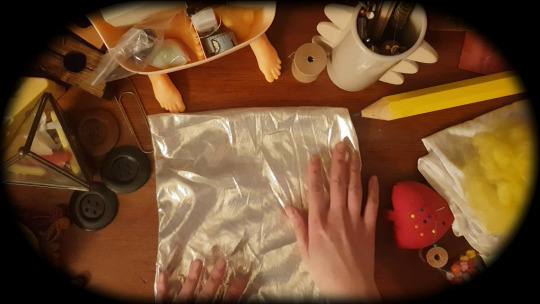
Use shiny fabric.
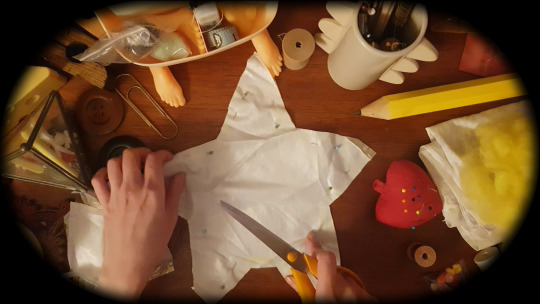
Cut fabric into a star shape with a flat bottom (for his bum).
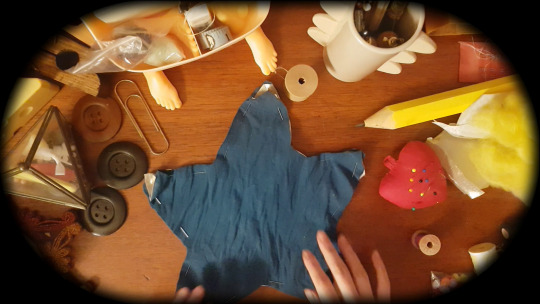
Line your star cut-out with your liner fabric (you may skip this part if you feel like your shiny fabric is strong / thick enough).
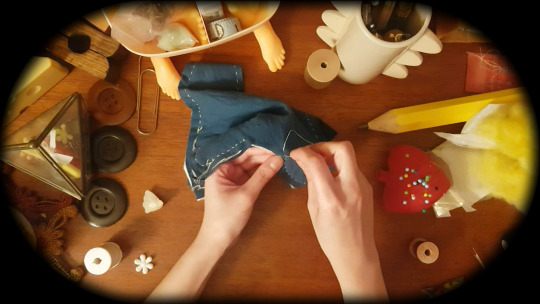
Sew the star with back-stitch. Leave the bottom hole open.

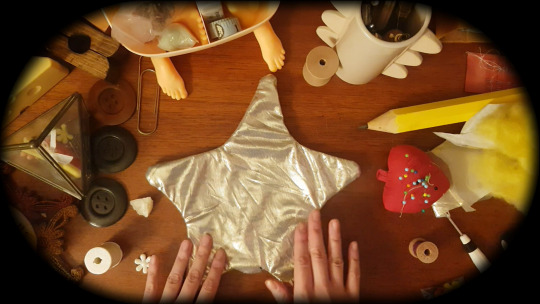
Flip that star through the bottom hole and set it aside.
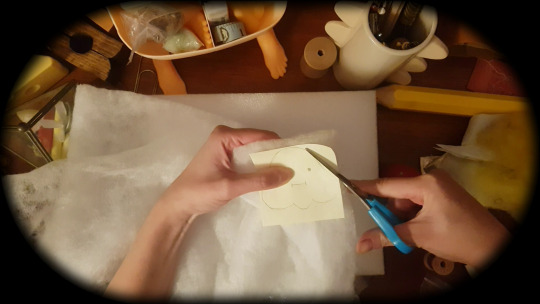
Draw a mock-up of Albert's face and cut a few layers of poly batting in approximately his shape. If you are using poly fill instead, you can skip this part and start needle felting a rough base shape shown in next step.
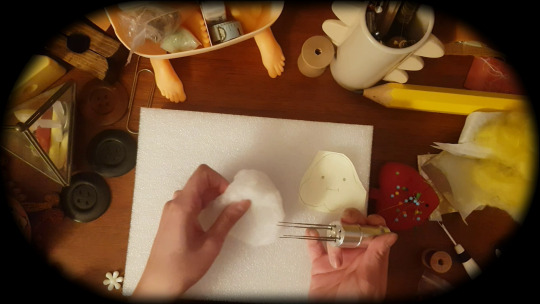
Stab it some.

To speed up the felting of the base, use soap and hot water to gently massage it until it starts feeling noticeably more felted. You may skip this step if you have more patience than me at stabbing.

Add facial features with core wool such as cheeks, chin, and forehead.
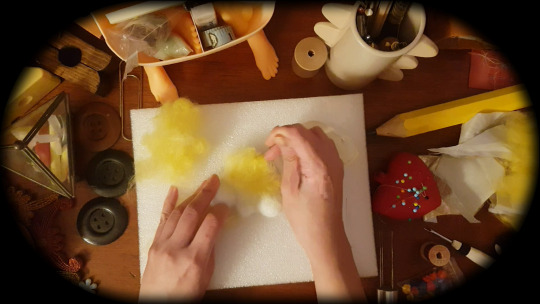
Add top wool.
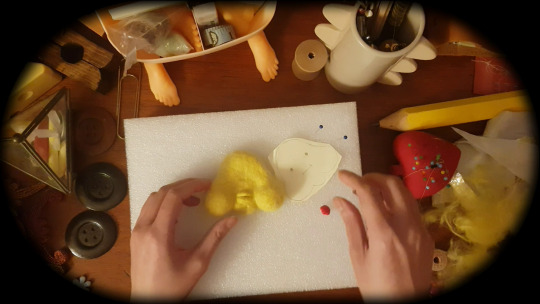
As well as smaller facial features like lips.

Cut glass pins to length so they don't poke through the face. Bend them downward a little and pin at a slight angle downward so they more secure (than poking them straight towards the back).
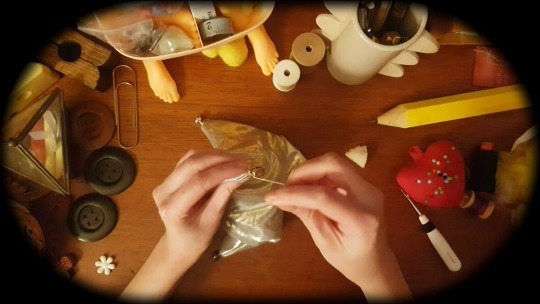
Sew your optional bells at the five tips of Albert’s body.
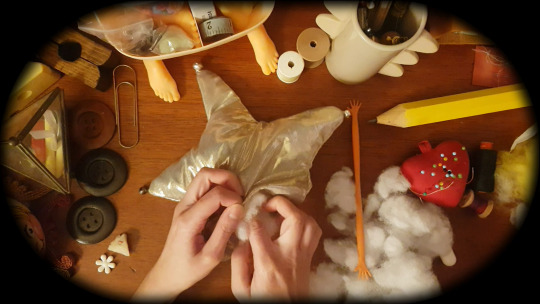
Stuff Albert with poly fill.
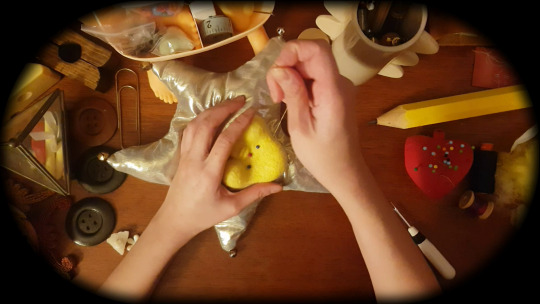
Sew Albert's face on his body. Put him aside.
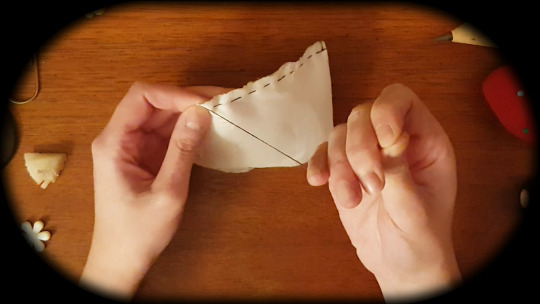
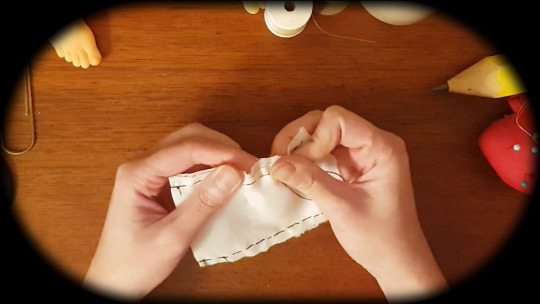
For Albert's guts, it's just a small pocket. Cut out a piece of rectangle that is roughly the width of his bottom hole and cut the length at double however long your christmas tree tip is. Mine was around 6ish" long that folded into a 3" deep pocket. Sewn with running stitch back and forth.

Flip his gut pocket inside out. Shove it at his bottom. Sew it onto its body (make sure to sew it to the top and lining fabric together for strength cause that part will need it).
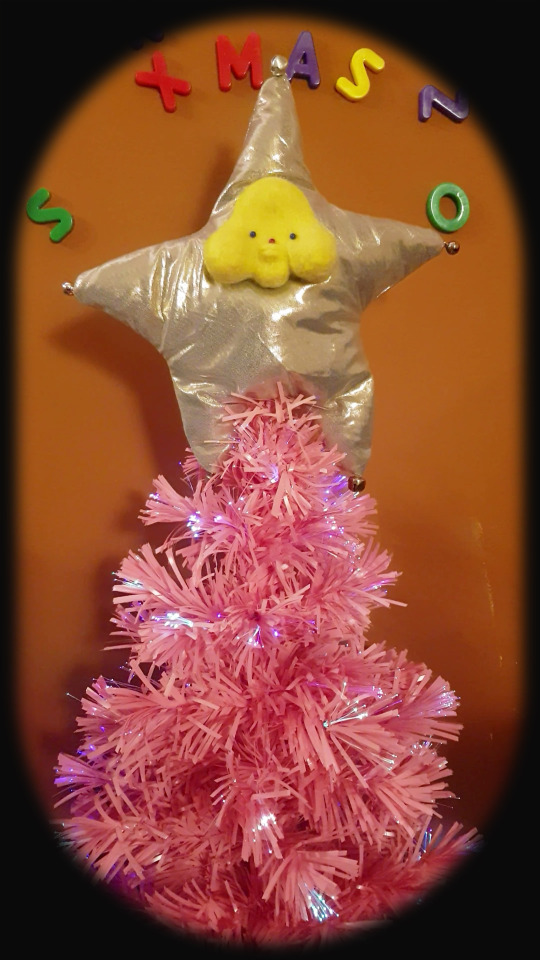
And you have yourself an Albert*.
*Albert means noble and bright!
#crafting#crafts#cute art#upcycle#arts and crafts#art#fiber art#handsewn#upcycling#hand sewing#christmas crafts#craftblr#textile crafts#hand crafted#diy#handmade#ideas#christmas#chrustmas tree topper#xmas crafts#xmas#sewblr#plushie#plushies#plushcore#plush toy#plushblr#clowncore#clown art#kidcore
10 notes
·
View notes
Text
Update! General costuming.
I’ve spent a big blow on EVA foam. Black and white with like 6-8mm thickness in big sheets. I heard of TNT cosplay supply before years and finally i will try their product and see if its worth that 50$ bucks.
No need to buy another fur for Thwok (Yet…). The fur ive gotten doubles as two colors depending on its shave. See it below? I don’t have a pic of the actual shaved test Square but 🤪

MORE BELOW!
I was thinking also that my play-fur quality blanket ive recycled could be used for very fun and whimsical fur! Its white and incredibly whispy n’ floaty.
Along with some fursuitsupplies fur from years ago in white, black and red. ( scraps tho.) and some beautifully soft and shiny teddy-style fur in black i nailed at joanns a long time ago too! (Scraps too.)
I’ve mocked up some monsterous creatures with these colors in mind. (Mostly if i have remaining fur from thwok. ) To make sweet monsters. See below.

I prefer the general shape of “Strudel” monster. The big eye and four ears are quite cute! I also want to possibly in the future, make a creature with mask-vision through nostrils, mouth, etc.
we will see if i make a monster like these in the later years. I hope yall stick around till then! And furthermore!
3 notes
·
View notes
Text
The Character vs. The Cosplay Ghost Pokemon Edition!
First up is Mimikyu!
Photos by Nude Carbon Studio



I made this cosplay almost completely out of recycled and scrap materials. A majority of this cosplay is made from old curtains I bought for the first house I ever rented. The black details were added using some black fabric paint I had laying around. The ears are made from some scrap craft foam to hold the shape, then stuffed with fluff from some old pillows, sewn onto the hood and the hood is attached to an old headband I had laying around.
Purchase pieces include the tutu, and whatever leggings/shirt combo I end up wearing underneath it 😂
I really need to make a tail prop for this. Because even though I continue to threaten it's retirement... It's so comfortable I just keep wearing it! And it's one of the few cosplays I have where I prefer it with a mask on.
5 notes
·
View notes
Text
The application and difficulties of foam densifier recycling automotive EPP waste packaging
Expanded Polypropylene (EPP) foam is a common material used in the automotive industry for part packaging and protection. Because of its exceptional cushioning qualities and durability, EPP is perfect for moving and storing vehicle parts. However, as usage grows, there is a growing environmental concern about how to recycle these waste components from EPP packaging. The main procedures and difficulties involved in recycling automobile EPP scrap packaging will be discussed in this article.
Shredded car EPP packaging is the initial stage of recycling. Using the foam densifier's crushing feature, first chop large EPP packaging into uniformly sized little pieces. The foam densifier's heating component can be used to melt and heat these tiny bits, making storage and transit simple.

Using an extrusion molding technique, the compressed EPP scrap can be recycled into new EPP goods, including as packaging materials or interior car parts. To further achieve resource recycling, EPP waste can also be utilized as raw materials or filler for further industrial goods.
Install specialized EPP waste recycling stations in vehicle repair and manufacturing facilities, and buy a foam densifier to aid in the centralized collection and processing of waste materials. To guarantee that EPP packaging waste is efficiently categorized and recycled and to minimize the mixing of other waste materials, develop a uniform waste management procedure. Establishing a network of recycling partners, cutting expenses, and increasing the effectiveness of centralized recycling are all possible with the optimization of the recycling logistics system.

Recycling used automotive EPP packaging not only lessens the impact on the environment but also increases the effectiveness of resource use. Through the implementation of cutting-edge recycling technology, streamlining recycling procedures, enhancing packaging design and production methods, securing regulatory backing, and encouraging public involvement, we can effectively address the issue of EPP packaging waste and accomplish sustainable growth.
0 notes
Text

Wire Bale Ties
Bale ties from Quick Pak Inc are the choice of recyclers, packagers, grocery stores, retailers, and municipalities across the U.S. They can be packaged to your requirements, stackable boxes, and crates, straight, single packs.
Single-loop: is recommended for baling cardboard, plastic, lumber, hay, and fabrics. Available in galvanized wire, 10-gauge to 15-gauge, length up to 24 feet, and either 125 or 250 ties per bundle. Our bale ties are available in 11-gauge to 14-gauge, length up to 23 feet, and in various ties per bundle.
Double-loop: is recommended for highly compressible materials: tires, foam, scrap metal. Our basic ties are available in 9-gauge to 13.5-gauge, lengths up to 19 feet, and various ties per bundle.
Available for Delivery Nationwide. Top Quality Ties Ensure Easy Handling.
Get your price today. Call Quick Pak Inc @ 813 242 6995 or reach out to [email protected] for your quick quote!
#bale wire#single loop#double loop bale wire#quickpakinc#stretch film pricing#resin pricing#pricing news#stretch film#quick pak inc#free pallet wrapper#coreless film#youtube
0 notes
Text
How to Choose the Right Carpet Padding for Comfort and Durability?

Introduction
When it comes to selecting the perfect carpet for your home, the focus often falls on color, texture, and style. However, the comfort and longevity of your carpet also heavily depend on one often-overlooked element: carpet padding. High-quality carpet padding is essential for ensuring both comfort underfoot and the durability of your carpet. In this blog, we'll guide you through the various carpet padding options available, helping you make an informed decision that best suits your needs.
Why Carpet Padding Matters
Carpet padding is the layer of material that sits between your carpet and the subfloor. It acts as a cushion, providing comfort, reducing wear and tear, and improving insulation. Without proper padding, your carpet may wear out quickly, feel less comfortable, and fail to offer adequate protection against noise and cold.
Carpet Padding Options: What to Consider
Choosing the right carpet padding involves considering several factors, including the type of carpet you have, the room's purpose, and your budget. Here are some of the most common carpet padding options to consider:
Rebond Padding
Overview: Rebond padding is made from recycled foam scraps, making it an eco-friendly option. It's one of the most popular choices due to its affordability and versatility.
Best for: Residential spaces like living rooms and bedrooms.
Pros: Cost-effective, widely available, and suitable for most carpets.
Cons: May not be as durable in high-traffic areas.
Memory Foam Padding
Overview: Memory foam padding offers superior comfort by conforming to the shape of your feet. It provides a luxurious feel, making it a popular choice for bedrooms.
Best for: Areas where comfort is a priority, such as bedrooms or sitting rooms.
Pros: Extremely comfortable, great for reducing foot fatigue.
Cons: Can be more expensive and may not offer the same durability in high-traffic areas.
Rubber Padding
Overview: Rubber padding is highly durable and offers excellent insulation against noise and temperature. It's often used in commercial spaces due to its resilience.
Best For: High-traffic areas like hallways and commercial spaces.
Pros: Long-lasting, moisture-resistant, and great for noise reduction.
Cons: Can be more expensive than other options, and may feel firmer underfoot.
Frothed Foam Padding
Overview: Frothed foam padding is made by injecting foam into a mold, creating a dense and durable padding option. It provides excellent support and is suitable for most carpets.
Best for: High-traffic residential areas and commercial spaces.
Pros: Durable, supportive, and resistant to crushing.
Cons: Higher cost compared to rebond padding.
Fiber Padding
Overview: Fiber padding is made from natural or synthetic fibers. While it's not as soft as foam or rubber, it's an excellent choice for low-pile carpets.
Best For: Low-pile carpets and commercial spaces.
Pros: Affordable, moisture-resistant, and eco-friendly options available.
Cons: Less cushiony feel compared to foam or rubber.
Tips for Choosing High-Quality Carpet Padding
Match Padding to Carpet Type: Ensure that the padding thickness and density match the type of carpet you’re installing. For example, a plush carpet may require a thicker pad for extra comfort, while a low-pile carpet might work better with a thinner, denser pad.
Consider Traffic Levels: For high-traffic areas, opt for more durable options like rubber or frothed foam padding. These types are designed to withstand heavy use without losing their shape or effectiveness.
Balance Comfort and Durability: While comfort is important, durability is key to ensuring your carpet lasts. Choose a padding that offers a good balance of both, depending on the room's use.
Don’t Skimp on Quality: High-quality carpet padding may have a higher upfront cost, but it can save you money in the long run by extending the life of your carpet and providing better comfort and insulation.
Conclusion
Selecting the right carpet padding is a crucial step in ensuring that your carpet remains comfortable and durable for years to come. By considering the various carpet padding options and understanding the specific needs of your space, you can make an informed choice that enhances both the comfort and longevity of your carpet. Remember, investing in high-quality carpet padding is a smart move that pays off in the long run.
0 notes
Text
Top 6 Sustainable Construction Materials for a Green Future
As the world grapples with the impacts of climate change, the construction industry is undergoing a significant transformation. Sustainable construction materials are at the forefront of this change, offering environmentally friendly alternatives that reduce the carbon footprint and promote a greener future. In this article, we'll explore the top six sustainable construction materials that are revolutionizing the industry, providing a path to more eco-friendly building practices.
1. Recycled Steel
Recycled steel is one of the most sustainable construction materials available today. Unlike traditional steel production, which is energy-intensive and generates significant carbon emissions, recycled steel uses scrap metal, significantly reducing environmental impact. Steel can be recycled multiple times without losing its strength or quality, making it an excellent choice for sustainable construction.
Using recycled steel in construction not only conserves natural resources but also reduces the amount of waste sent to landfills. This material is incredibly versatile, suitable for a variety of applications, from structural frameworks to roofing and siding. At TeamHome, we offer a range of construction services that incorporate recycled steel, ensuring that your building project is both robust and environmentally responsible.
2. Bamboo
Bamboo is rapidly gaining popularity as a sustainable construction material due to its fast growth rate and renewable nature. Unlike traditional hardwoods, which can take decades to mature, bamboo can be harvested in as little as three to five years. This rapid renewability makes bamboo an excellent alternative to conventional timber.
Bamboo is incredibly strong and flexible, making it ideal for a wide range of construction applications, from flooring and wall panels to structural components. Additionally, bamboo absorbs more carbon dioxide and releases more oxygen compared to many other plants, contributing to better air quality and a reduced carbon footprint. TeamHome Building construction in Bangalore promotes the use of bamboo in construction projects, ensuring that we contribute to sustainable building practices and the preservation of natural forests.
Bamboo also offers aesthetic appeal, with its natural grain and warm tones adding a touch of elegance to any building. It can be treated and finished in various ways to match different design preferences, making it a popular choice for eco-conscious architects and designers
3. Reclaimed Wood
Reclaimed wood is another excellent sustainable construction material that has gained traction in recent years. This material is sourced from old buildings, barns, and other structures that are no longer in use. By repurposing this wood, we can reduce the demand for new timber, preserving forests and minimizing environmental impact.
Reclaimed wood offers a unique aesthetic appeal, with each piece carrying its own history and character. It's perfect for both structural and decorative applications, providing a rustic charm that new wood often lacks. TeamHome specializes in integrating reclaimed wood into our construction projects, offering clients a sustainable option that doesn't compromise on style or quality.
Recycled steel is suitable for a wide range of construction applications, including framing, roofing, and reinforcing concrete. Its versatility and strength make it an ideal choice for sustainable building projects, from residential homes to large commercial structures.
4. Insulated Concrete Forms (ICFs)
Insulated Concrete Forms (ICFs) are an innovative sustainable construction material that combines the strength of concrete with excellent insulation properties. ICFs consist of interlocking foam blocks that are filled with concrete, creating a highly energy-efficient building envelope. This construction method reduces energy consumption by improving thermal insulation, leading to lower heating and cooling costs.
At TeamHome, Building construction in Bangalore we incorporate ICFs into our building projects to enhance energy efficiency and sustainability. ICFs are also highly durable and resistant to natural disasters, making them an ideal choice for building in areas prone to extreme weather conditions. The use of ICFs in construction reduces the need for additional insulation materials, further minimizing the environmental impact.
5. Hempcrete
Hempcrete is a sustainable construction material made from the woody core of the hemp plant mixed with lime and water. This lightweight, bio-composite material offers excellent insulation properties and is highly breathable, reducing the risk of mold and dampness in buildings. Hempcrete is also carbon-negative, meaning it absorbs more carbon dioxide during its growth than is emitted during its production.
Hempcrete is versatile and can be used for walls, floors, and roofs. It is also fire-resistant, non-toxic, and resistant to mold and pests, making it a durable and healthy building material. Hempcrete's breathability helps regulate humidity levels, contributing to a comfortable and healthy indoor environment
Hemp is a fast-growing plant that requires minimal pesticides and herbicides, making it an environmentally friendly crop. The use of hempcrete in construction contributes to sustainable building practices by reducing reliance on traditional, energy-intensive materials like concrete. TeamHome Building construction in Bangalore advocates for the use of hempcrete in our projects, providing clients with a green alternative that supports a healthier environment.
6. Solar Panels and Photovoltaic Glass
Renewable energy integration is a critical aspect of sustainable construction materials , and solar panels are at the forefront of this movement. Solar panels harness energy from the sun, providing a clean, renewable source of power for buildings. The installation of solar panels can significantly reduce a building's reliance on fossil fuels, leading to lower energy costs and a reduced carbon footprint.
Photovoltaic (PV) glass is an emerging technology that incorporates solar cells into building glass, allowing windows and facades to generate electricity. This innovative material combines energy generation with aesthetic appeal, making it an attractive option for modern, sustainable buildings. TeamHome offers expertise in the installation of solar panels and PV glass, helping clients harness the power of renewable energy in their construction projects.
When it comes to building a sustainable future, choosing the right construction materials is crucial. TeamHome is a leading construction company committed to promoting sustainability and using eco-friendly materials in their projects. As experts in sustainable construction, TeamHome can help you design and build green structures that are both beautiful and environmentally responsible.
Why Choose TeamHome?
1. Sustainable Practices: TeamHome is dedicated to using sustainable construction material and practices that minimize environmental impact. From sourcing eco-friendly materials to implementing energy-efficient building techniques, they ensure that every project contributes to a greener future.
2. Expertise and Experience: With years of experience in the construction industry, TeamHome has the knowledge and expertise to execute sustainable building projects of all sizes. Their team of skilled professionals is well-versed in the latest green building technologies and standards.
3. Custom Solutions: TeamHome offers customized building solutions tailored to your specific needs and preferences. Whether you're looking to construct a new home, renovate an existing structure, or develop a commercial property, TeamHome can create a sustainable design that meets your goals.
4. Quality and Durability: TeamHome is committed to delivering high-quality construction that stands the test of time. By using durable and sustainable construction materials, they ensure that your building is not only eco-friendly but also built to last.
5. Customer Satisfaction: At TeamHome, customer satisfaction is a top priority. Their team works closely with clients throughout the entire construction process, providing clear communication, transparency, and exceptional service.
Conclusion
The adoption of sustainable construction material is essential for creating a greener future. Recycled steel, bamboo, reclaimed wood, insulated concrete forms, hempcrete, and solar panels are leading the way in this transformation, offering environmentally friendly alternatives that do not compromise on quality or performance. These materials not only reduce the carbon footprint of construction projects but also contribute to the conservation of natural resources and the promotion of renewable energy.
At TeamHome,we are committed to sustainable building practices and the use of eco-friendly materials in our projects. By incorporating these innovative materials, we help our clients achieve their sustainability goals while creating durable, energy-efficient structures. Choose TeamHome for your next construction project and join us in building a greener, more sustainable future.
0 notes
Text
Polyisocyanurate Foam Disposal Experts
Disposing of polyisocyanurate foam (often used in insulation) requires careful handling due to its composition and potential environmental impact. Here are some key points to consider when discussing disposal:
Environmental Impact: Polyisocyanurate foam can release toxic gases if burned or improperly disposed of in landfills. It contains chemicals that may be harmful to the environment if they leach into soil or water.
Recycling Options: Look for facilities that specialize in recycling polyisocyanurate foam. Some companies accept used foam for reprocessing into new materials or products, reducing waste and environmental impact.
Specialized Disposal Services: Certain waste management companies or environmental service providers may offer specialized disposal services for polyisocyanurate foam. They can ensure that the foam is handled and disposed of properly according to regulations.
Local Regulations: Check local regulations and guidelines for disposing of polyisocyanurate foam. Different regions may have specific rules regarding its disposal to minimize environmental impact and ensure compliance with safety standards.
Safety Measures: When handling polyisocyanurate foam, wear appropriate protective gear to prevent skin contact or inhalation of particles. Dispose of any scraps or waste in sealed containers to minimize exposure.
#spray foam insulation removal#spray foam insulation problems#spray foam removal services#spray foam removal#spray foam insulation#roof repairs service#spray foam removal & equity release
0 notes
Text
"Consumer Awareness Drives Expansion in Recycled Plastic Sector"
Recycled Plastics Market size is expected to be worth around USD 114.8 billion by 2033, from USD 52.7 billion in 2023, growing at a CAGR of 8.1% during the forecast period from 2023 to 2033.
This market encompasses the entire recycling process, including the collection, sorting, cleaning, and reprocessing of discarded plastics into raw materials that can be used in manufacturing. Recycled plastics are derived from various sources, such as post-consumer waste (like plastic bottles, packaging materials, and other discarded consumer products) and post-industrial waste (such as scraps and offcuts from manufacturing processes).
The market for recycled plastics is driven by increasing environmental awareness, regulatory policies promoting sustainability, and the rising demand for eco-friendly materials in various industries.
The growth of online sales for personal care and Personal Protective Equipment (PPE) products further boosts the demand for recycled plastics, as companies seek to package their products in sustainable materials.
Download a sample report in MINUTES@ https://market.us/report/recycled-plastics-market/request-sample/

Key Market Segment
Plastic Type
Polyethylene
Polyethylene Terephthalate
Polypropylene
Polyvinyl Chloride
Polystyrene
Other Products
Source
Plastic Bottles
Plastic Films
Polymer Foam
Other Sources
Application
Building & Construction
Packaging of Products
Electrical & Electronics
Textiles
Automotive
Other Applications
Plastic Type
Polyethylene Terephthalate dominates the recycled plastics market with a 29.3% share in 2023, driven by its demand in packaging across food, beverage, and consumer goods industries, while Polypropylene is crucial for its chemical and mechanical properties in sectors like medical devices, automotive, and construction.
Source Channel
Plastic bottles, accounting for 65% of global recycled plastics revenue in 2023, are the primary source of recycled materials, extensively used in packaging oils, pharmaceuticals, and beverages.
Application Analysis
In 2023, the packaging industry led the recycled plastics market, contributing over 42.1% of global revenue, driven by rising demand for packaged food, beverages, electronics, and textiles, particularly in the Asia Pacific region.
Key Market Players
Veolia
Plastipak Holdings, Inc.
SUEZ SA
Ultra Poly Corporation
Fresh Pak Corporation
B&B Plastics Recycling Inc.
Alpek S.A.B. de C.V.
Indorama Ventures
Far Eastern New Century Corporation
Envision Plastics Industries
Custom Polymers, Inc.
Berry Global Inc.
Other Key Players
Driver
The increasing adoption of recycled plastic in the packaging industry, particularly for food and beverage products, is driven by the material's effectiveness in ensuring product safety and environmental sustainability.
Restraint
The preference for virgin plastics over recycled alternatives, due to quality concerns and cost advantages, restricts the market growth despite regulatory pressures.
Opportunity
Favorable initiatives and regulations in developed countries, such as tax incentives and public funding for recycling projects, promote the use of recycled plastics, creating growth opportunities.
Challenge
The major challenge for the recycled plastics market is the difficulty in collecting sufficient plastic waste, as only 14% of used plastic packaging is currently recycled, necessitating new collection methods to capture the remaining 86%.
0 notes
Text
How to Make an Arduino Floor Cleaner Robot
Welcome back to another captivating instructable. In this endeavor, I’ve crafted an Arduino-powered floor cleaner robot, which operates significantly quieter than typical models.
Yes, you heard that correctly! This is a straightforward yet fully operational dry floor cleaner capable of picking up items from the floor such as paper scraps, hair, foam fragments, leftover chips from a party, and much more!
Materials Needed
To replicate this project, I’ve listed all the necessary components that are easily accessible. Should you wish to construct this robot, I’ve provided detailed instructions in this guide, enabling anyone to assemble and enjoy the process.
Arduino Uno (Available on Amazon)
Ultrasonic Sensor (HC-SR04)
L298N Motor Driver Module
DC fan, switch, and battery source
Sturdy Cardboard
Two BO Motors with wheels
Two 18650 Batteries
Battery Holder with Separate Switch
Jumper Wires
Paper glue
Plastic wire mesh
Spare wheel
Piece of steel or toothpick
Super glue and hot glue
Soldering iron and wire
Arduino IDE and programming cable
Please note that using Amazon affiliate links may provide me with a small commission at no extra cost to you, which helps support my projects.
How Does This Robot Operate?
The functionality of this robot is quite elementary. The board is programmed so that upon activation, the robot advances forward, with the HC-SR04 sensor scanning for obstacles. When an obstruction is detected, the robot halts, reverses, and then continues forward in a different direction. This cycle repeats, ensuring most floor areas are covered. During this process, the fan remains active, collecting debris from the floor.
To empty the collected debris, simply lift the robot, position it over a dustbin, and turn off the fan, causing the particles to drop out.
Step-by-Step Guide
Step 1: Constructing the Frame
The frame is crucial as it houses all the electronics and mechanisms. Though cardboard might seem flimsy, using a recycled package container and reinforcing it with multiple layers provides sufficient strength. I crafted discs from the cardboard, adhered them with paper glue, and allowed them to dry thoroughly. Marking areas for the fan and wheels, I cut the base accordingly.
Step 2: Circuit Diagram and Codes
To simplify the circuit explanation:
Ultrasonic Sensor:
VCC to 5V on Arduino
GND to GND on Arduino
Trig to Pin 8 on Arduino
Echo to Pin 9 on Arduino
Arduino Uno Connection with Motor Driver and Battery:
Vin pin to 5V pin of the driver
GND to GND of driver
12V pin to positive pin of driver
L298N Motor Driver Connections with Uno:
IN1 to D4 on Arduino
IN2 to D5
IN3 to D6
IN4 to D7
ENA to D10 and ENB to pin D11
GND to GND on Arduino
VCC to Battery positive
Motor 1 Outputs to Motor 1
Motor 2 Outputs to Motor 2 Terminals
Fan:
The DC fan requires 12V for optimal performance. Using a 7.4V battery source, connect the battery to the fan and control it with a simple switch.
After assembling the circuit, connect the USB to Arduino, upload the code, then disconnect the USB.
Step 3: Suction Fan and Front Wheel
Install the DC fan, ensuring no obstacles hinder its operation. Attach the fan to the frame with glue. For movement, two BO motors control the robot, and an additional wheel installed at the front stabilizes it.
Step 4: Adding the Circuit
Secure the circuit components firmly to the base to prevent loose connections. Glue the electronics first, then attach the BO motors and wheels using hot glue. Ensure the glue isn’t too hot to avoid deforming the motor frame. Secure the power source with zip ties.
Step 5: Suction Cylinder
The suction cylinder collects lightweight objects. The powerful DC fan lifts the debris, and a plastic mesh filters and contains it, allowing air to flow freely. Construct the cylinder with cardboard, sealing one end with the mesh and gluing the other end to the frame.
Step 6: Finishing and Testing
Ensure all components are securely attached to the frame. Connect the battery, turn on the fan and main circuit switches, and test the robot. Place light objects like paper bits or foam pieces in its path to see the robot in action.
Conclusion
The project should now be fully operational. Remember, this robot is designed to pick up only lightweight objects and is not suitable for liquids or larger items.
Explore more engaging projects and enhance your coding skills with our specialized courses:
Python for Kids Course: A beginner-friendly introduction to Python programming.
Java Course: Comprehensive lessons on Java programming.
AI Discovery Course: Learn the fundamentals of AI and its applications.
AI Evolution Course: Understand the progression of AI technologies.
Do you have questions regarding our STEM program?
Contact us anytime.
Take your first step into the magical world of coding for kids
0 notes
Text
Personalizing Your Child's Bedroom: DIY Wall Art Ideas
When it comes to decorating your child's bedroom, the options are endless. With a little creativity and some DIY spirit, you can transform their space into a magical, personalized haven. Not only does this approach make their room unique, but it also allows you to bond with your child as you create something special together. In this blog post, we'll explore some fantastic DIY wall art ideas that will enhance your kids' room decor and complement their kids' room furniture from Alex Daisy.

Why DIY Wall Art?
DIY wall art is an excellent way to add a personal touch to your child's bedroom. It's affordable, customizable, and fun to make. Plus, it allows Kids room furniture to portray your child's personality and interests. Whether your little one loves animals, space, or fairy tales, you can create wall art that reflects their passions.
Getting Started: Supplies You'll Need
Before diving into our DIY wall art projects, let's gather some basic supplies:
Canvas or sturdy cardboard
Paints and brushes
Stencils
Glue and scissors
Decorative paper or fabric
Frames (optional)
Adhesive hooks or nails for hanging
Having these supplies on hand will make the process smoother and more enjoyable.
1. Handprint Art
One of the simplest yet most heartfelt DIY wall art ideas is handprint art. This project is perfect for young children and can become a treasured keepsake as they grow.
Instructions:
1. Choose a Canvas: Pick a canvas size that fits the wall space you have in mind.
2. Select Paint Colors: Let your child choose their favorite colors. Non-toxic, washable paints are best.
3. Create Handprints: Dip your child's hand in the paint and press it onto the canvas. You can create patterns, shapes, or even animals by arranging the handprints creatively.
4. Personalize It: Add your child's name and the date to remember when it was made.
This project is simple yet meaningful, and it will add a vibrant splash of color to the room.
2. Collage Wall Art
Collages are a fantastic way to incorporate a mix of images, textures, and colors into your kids room decor. It's also a great way to recycle old magazines, wrapping paper, or fabric scraps.
Instructions:
1. Gather Materials: Collect magazines, colored paper, fabric pieces, stickers, and any other decorative items.
2. Cut and Arrange: Cut out interesting shapes, pictures, and patterns. Arrange them on a canvas or sturdy cardboard until you're happy with the design.
3. Glue Everything: Once you're satisfied with the layout, glue the pieces in place.
4. Frame It: For a polished look, consider framing the collage.
This project encourages creativity and allows your child to have a hand in designing their wall art.
3. Alphabet Wall
Creating an alphabet wall is not only decorative but also educational. This project can help your child learn letters and improve their reading skills.
Instructions:
1. Choose a Theme: Decide whether you want a colorful, whimsical alphabet or a more modern, minimalist look.
2. Create Letters: Cut out large letters from cardboard or buy pre-cut wooden or foam letters.
3. Decorate: Paint the letters or cover them with decorative paper or fabric.
4. Arrange and Hang: Arrange the letters on the wall in a grid or a more random pattern. Use adhesive hooks or nails to hang them.
This project is versatile and can grow with your child as they learn and develop.
4. Fairy Tale Silhouettes
For children who love fairy tales, creating silhouette wall art can be enchanting. This project can bring their favorite stories to life right in their bedroom.
Instructions:
1. Choose Characters: Pick silhouettes of their favorite fairy tale characters, such as dragons, princesses, or castles.
2. Create Stencils: Print out the silhouettes and use them as stencils on black paper or cardboard.
3. Cut Out and Paint: Cut out the silhouettes and paint them in black or another color of your choice.
4. Mount on Canvas: Glue the silhouettes onto a contrasting background canvas.
5. Hang on the Wall: Use adhesive hooks to display the finished pieces.
This type of wall art adds a touch of magic and can inspire your child's imagination.
5. Nature-Inspired Art
Bringing elements of nature into your child's room can create a calming and beautiful atmosphere. This project is perfect for kids who love the outdoors.
Instructions:
1. Collect Natural Items: Gather leaves, flowers, twigs, and small stones.
2. Create Prints: Use leaves and flowers to create prints on canvas by painting one side and pressing them onto the surface.
3. Arrange and Glue: Once dry, arrange additional natural items on the canvas and glue them in place.
4. Frame It: For added durability and a finished look, frame the artwork.
This project helps your child appreciate nature and brings a bit of the outdoors inside.
Conclusion
Creating DIY wall art for your child's bedroom is a rewarding and enjoyable experience. It allows you to personalize their space while making lasting memories together. By incorporating these ideas into your kids' room decor, you can complement their kids' room furniture from Alex Daisy and create a unique and vibrant environment. So, gather your supplies and let your creativity flow. Your child's dream bedroom is just a project away!
Originally Published At: https://alexdaisyy.blogspot.com/2024/05/personalizing-your-childs-bedroom-diy.html
0 notes
Text
Top 6 Sustainable Construction Materials for a Green Future
As the world grapples with the impacts of climate change, the construction industry is undergoing a significant transformation. Sustainable construction materials are at the forefront of this change, offering environmentally friendly alternatives that reduce the carbon footprint and promote a greener future. In this article, we'll explore the top six sustainable construction materials that are revolutionizing the industry, providing a path to more eco-friendly building practices.
1. Recycled Steel
Recycled steel is one of the most sustainable construction materials available today. Unlike traditional steel production, which is energy-intensive and generates significant carbon emissions, recycled steel uses scrap metal, significantly reducing environmental impact. Steel can be recycled multiple times without losing its strength or quality, making it an excellent choice for sustainable construction.
Using recycled steel in construction not only conserves natural resources but also reduces the amount of waste sent to landfills. This material is incredibly versatile, suitable for a variety of applications, from structural frameworks to roofing and siding. At TeamHome, we offer a range of construction services that incorporate recycled steel, ensuring that your building project is both robust and environmentally responsible.
2. Bamboo
Bamboo is rapidly gaining popularity as a sustainable construction material due to its fast growth rate and renewable nature. Unlike traditional hardwoods, which can take decades to mature, bamboo can be harvested in as little as three to five years. This rapid renewability makes bamboo an excellent alternative to conventional timber.
Bamboo is incredibly strong and flexible, making it ideal for a wide range of construction applications, from flooring and wall panels to structural components. Additionally, bamboo absorbs more carbon dioxide and releases more oxygen compared to many other plants, contributing to better air quality and a reduced carbon footprint. TeamHome promotes the use of bamboo in construction projects, ensuring that we contribute to sustainable building practices and the preservation of natural forests.
3. Reclaimed Wood
Reclaimed wood is another excellent sustainable construction material that has gained traction in recent years. This material is sourced from old buildings, barns, and other structures that are no longer in use. By repurposing this wood, we can reduce the demand for new timber, preserving forests and minimizing environmental impact.
Reclaimed wood offers a unique aesthetic appeal, with each piece carrying its own history and character. It's perfect for both structural and decorative applications, providing a rustic charm that new wood often lacks. TeamHome specializes in integrating reclaimed wood into our construction projects, offering clients a sustainable option that doesn't compromise on style or quality.
4. Insulated Concrete Forms (ICFs)
Insulated Concrete Forms (ICFs) are an innovative sustainable construction material that combines the strength of concrete with excellent insulation properties. ICFs consist of interlocking foam blocks that are filled with concrete, creating a highly energy-efficient building envelope. This construction method reduces energy consumption by improving thermal insulation, leading to lower heating and cooling costs.
ICFs are also highly durable and resistant to natural disasters, making them an ideal choice for building in areas prone to extreme weather conditions. The use of ICFs in construction reduces the need for additional insulation materials, further minimizing the environmental impact. At TeamHome, we incorporate ICFs into our building projects to enhance energy efficiency and sustainability.
5. Hempcrete
Hempcrete is a sustainable construction material made from the woody core of the hemp plant mixed with lime and water. This lightweight, bio-composite material offers excellent insulation properties and is highly breathable, reducing the risk of mold and dampness in buildings. Hempcrete is also carbon-negative, meaning it absorbs more carbon dioxide during its growth than is emitted during its production.
Hemp is a fast-growing plant that requires minimal pesticides and herbicides, making it an environmentally friendly crop. The use of hempcrete in construction contributes to sustainable building practices by reducing reliance on traditional, energy-intensive materials like concrete. TeamHome advocates for the use of hempcrete in our projects, providing clients with a green alternative that supports a healthier environment.
6. Solar Panels and Photovoltaic Glass
Renewable energy integration is a critical aspect of sustainable construction materials , and solar panels are at the forefront of this movement. Solar panels harness energy from the sun, providing a clean, renewable source of power for buildings. The installation of solar panels can significantly reduce a building's reliance on fossil fuels, leading to lower energy costs and a reduced carbon footprint.
Photovoltaic (PV) glass is an emerging technology that incorporates solar cells into building glass, allowing windows and facades to generate electricity. This innovative material combines energy generation with aesthetic appeal, making it an attractive option for modern, sustainable buildings. TeamHome offers expertise in the installation of solar panels and PV glass, helping clients harness the power of renewable energy in their construction projects.
Conclusion
The adoption of sustainable construction materials is essential for creating a greener future. Recycled steel, bamboo, reclaimed wood, insulated concrete forms, hempcrete, and solar panels are leading the way in this transformation, offering environmentally friendly alternatives that do not compromise on quality or performance. These materials not only reduce the carbon footprint of construction projects but also contribute to the conservation of natural resources and the promotion of renewable energy.
At TeamHome,we are committed to sustainable building practices and the use of eco-friendly materials in our projects. By incorporating these innovative materials, we help our clients achieve their sustainability goals while creating durable, energy-efficient structures. Choose TeamHome for your next construction project and join us in building a greener, more sustainable future.
0 notes
Text
Rebonded Foam Mattress

A rebonded foam mattress offers the perfect blend of support and comfort for a rejuvenating sleep experience. Made from recycled foam scraps, this innovative mattress type undergoes a process of compression and bonding to create a durable and resilient sleeping surface. Ideal for those seeking excellent support and pressure relief, rebonded foam mattresses are known for their long-lasting quality and affordability. Upgrade your sleep with a rebonded foam mattress from Refresh Mattress and experience the difference in comfort and support.
0 notes